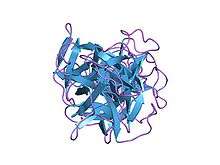Sea anemone neurotoxin
| Anemone neurotoxin | |||||||||
|---|---|---|---|---|---|---|---|---|---|
 Structure of the neurotoxin ATX Ia from Anemonia sulcata.[1] | |||||||||
| Identifiers | |||||||||
| Symbol | Toxin_4 | ||||||||
| Pfam | PF00706 | ||||||||
| Pfam clan | CL0075 | ||||||||
| InterPro | IPR000693 | ||||||||
| SCOP | 1atx | ||||||||
| SUPERFAMILY | 1atx | ||||||||
| OPM superfamily | 56 | ||||||||
| OPM protein | 1apf | ||||||||
| |||||||||
| Antihypertensive protein BDS-I/II | |||||||||
|---|---|---|---|---|---|---|---|---|---|
 Structure of the antihypertensive and antiviral protein BDS-I from the sea anemone Anemonia sulcata.[2] | |||||||||
| Identifiers | |||||||||
| Symbol | BDS_I_II | ||||||||
| Pfam | PF07936 | ||||||||
| Pfam clan | CL0075 | ||||||||
| InterPro | IPR012414 | ||||||||
| SCOP | 2bds | ||||||||
| SUPERFAMILY | 2bds | ||||||||
| OPM superfamily | 56 | ||||||||
| OPM protein | 1bds | ||||||||
| |||||||||
Sea anemone neurotoxin is the name given to neurotoxins produced by sea anemones with related structure and function. Sea anemone neurotoxins can be divided in two functional groups that either specifically target the sodium channel or the potassium channel.
A number of proteins belong to the sodium channel toxin family, including calitoxin and anthopleurin. The neurotoxins bind specifically to the sodium channel, thereby delaying its inactivation during signal transduction, resulting in strong stimulation of mammalian cardiac muscle contraction. Calitoxin 1 has been found in neuromuscular preparations of crustaceans, where it increases transmitter release, causing firing of the axons. Three disulfide bonds are present in this protein.[3][4][5]
This family also includes the antihypertensive and antiviral proteins BDS-I (P11494) and BDS-II (P59084) expressed by Anemonia viridis (previously Anemonia sulcata). BDS-I is organised into a triple-stranded antiparallel beta-sheet, with an additional small antiparallel beta-sheet at the N-terminus.[6] Both peptides are known to specifically block the Kv3.4 potassium channel, and thus bring about a decrease in blood pressure.[7] Moreover, they inhibit the cytopathic effects of mouse hepatitis virus strain MHV-A59 on mouse liver cells, by an unknown mechanism.[6]
The potassium channel toxin family include kaliseptine and kalicludines,[8] and was also isolated from Anemonia viridis.
See also
References
- ↑ Widmer H, Billeter M, Wüthrich K (1989). "Three-dimensional structure of the neurotoxin ATX Ia from Anemonia sulcata in aqueous solution determined by nuclear magnetic resonance spectroscopy". Proteins. 6 (4): 357–71. doi:10.1002/prot.340060403. PMID 2576133.
- ↑ Driscoll PC, Gronenborn AM, Beress L, Clore GM (March 1989). "Determination of the three-dimensional solution structure of the antihypertensive and antiviral protein BDS-I from the sea anemone Anemonia sulcata: a study using nuclear magnetic resonance and hybrid distance geometry-dynamical simulated annealing". Biochemistry. 28 (5): 2188–98. doi:10.1021/bi00431a033. PMID 2566326.
- ↑ Norton TR (1981). "Cardiotonic polypeptides from Anthopleura xanthogrammica (Brandt) and A. elegantissima (Brandt)". Fed. Proc. 40 (1): 21–5. PMID 6108877.
- ↑ Yasunobu KT, Norton TR, Reimer NS, Yasunobu CL (1985). "Amino acid sequence of the Anthopleura xanthogrammica heart stimulant, anthopleurin-B". J. Biol. Chem. 260 (15): 8690–3. PMID 4019448.
- ↑ Scanlon MJ, Pallaghy PK, Norton RS, Monks SA (1995). "Solution structure of the cardiostimulant polypeptide anthopleurin-B and comparison with anthopleurin-A". Structure. 3 (8): 791–803. doi:10.1016/s0969-2126(01)00214-3. PMID 7582896.
- 1 2 Clore GM, Driscoll PC, Gronenborn AM, Beress L (1989). "Determination of the three-dimensional solution structure of the antihypertensive and antiviral protein BDS-I from the sea anemone Anemonia sulcata: a study using nuclear magnetic resonance and hybrid distance geometry-dynamical simulated annealing". Biochemistry. 28 (5): 2188–2198. doi:10.1021/bi00431a033. PMID 2566326.
- ↑ Lazdunski M, Schweitz H, Diochot S, Beress L (1998). "Sea anemone peptides with a specific blocking activity against the fast inactivating potassium channel Kv3.4". J. Biol. Chem. 273 (12): 6744–6749. doi:10.1074/jbc.273.12.6744. PMID 9506974.
- ↑ Schweitz, Hugues; Bruhn, Thomas; Guillemare, Eric; Moinier, Danielle; Lancelin, Jean-Marc; Béress, László; Lazdunski, Michel (1995-10-20). "Kalicludines and Kaliseptine TWO DIFFERENT CLASSES OF SEA ANEMONE TOXINS FOR VOLTAGE-SENSITIVE K+ CHANNELS". Journal of Biological Chemistry. 270 (42): 25121–25126. doi:10.1074/jbc.270.42.25121. ISSN 0021-9258. PMID 7559645.
This article incorporates text from the public domain Pfam and InterPro IPR000693